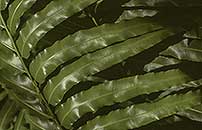Stenochlaena tenuifolia (Desv.) T. Moore
Synonyms |
Lomaria tenuifolia Desv. |
|---|---|
Common name |
|
Description |
Rhizome up to 20 m long and 1-2 cm in diameter, creeping along the ground or ascending trees; rhizome scales sparse, thick, entire, dark brown, awl-shaped, non persistent, 1-5 mm long. Fronds dimorphic, up to 4 m long, firmly membranous, arching, widely spaced. Stipe up to 150 x 1.5-2 cm long, pale (reddish) brown, grooved on the upper side, glabrous. Sterile lamina imparipinnate, ovate-oblong in outline, 0.5-2 × 0.2-0.7 m; pinnae about 20 alternate pairs, linear-lanceolate, glabrous, shortly petiolate, apex pointed, base unequally cuneate, margins minutely serrate, 15-35 × 2-3.9 cm. Fertile lamina 2-pinnate or rarely pinnate, usually slightly shorter than the sterile lamina, with 25-30 pairs of lateral pinnae; pinnae petiolate, up to 25 cm long, about 4 cm apart, pinnately divided into very irregular narrowly linear segments, up to 8 x 0.2 cm, adnate to the rhachis or petiolate at the base, glabrous above, completely covered with sporangia below, sori exindusiate. |
Notes | |
Derivation | tenuis: thin, folia: leaves; slender-leaved referring to the linear pinnae of the fertile frond. |
Habitat | Swamp forest, and swampy stream bottoms, mixed evergreen forest, also fringing forest, low altitude. |
Distribution worldwide | Africa, Madagascar, Galego I., Comoro Isl., Mauritius. |
Distribution in Africa |
Angola, Cameroon, Dem. Republic of Congo, Equatorial Guinea (incl. Bioko), Kenya, Mozambique, South Africa, Tanzania , Uganda, Zimbabwe. |
Growth form |
Terrestrial. |
Literature |
|



